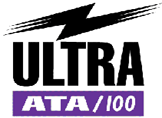Fastest IDE Hard Drive Ever: IBM Deskstar 75GXP
Technical Specifications
| IBM Deskstar 75GXP | |
|---|---|
| Capacity | 15, 20, 30, 45, 60, 75 GBytes |
| Rotation speed | 7.200 rpm |
| Average seek time | 8.5 ms |
| Cache memory | 2048 kBytes |
| Warranty time | 3 years |
Jumper Location and Setup Information can be found on the IBM Website .
Ultra ATA-100

The latest interface standard is gradually entering the IDE arena, enabling bandwidths of up to 100 MBytes/s. Some of you may wonder where's the need for such a fast IDE drive interface, as there is not one drive with a physical data transfer rate that is getting even close to the 66 MB/s of UltraATA/66.
It's important to realize that the IDE interface has to live with quite a large overhead, cutting off some hefty 25% of the theoretical bandwith. That leaves a real bandwith of 25 MBytes/s for UltraATA/33 and approximately 50 MBytes/s for UltraATA/66. Today, high performance drives deliver up to 35 MBytes/s. Of course you should attach those drives at least to an ATA/66 controller if you want to take full advantage of its performance. The next hard drive generation will likely reach the UltraATA/66 barrier, thus requiring the faster interface to provide top performance.
Besides the naked transfer speed, all hard drives have their own cache memory to store data according to certain algorithms in order to speed up the overall performance. While synthetic hard disk benchmarks might not benefit a whole lot of those caches, real-world applications run considerably faster on a hard drive with more cache memory. Naturally, the cache has to be noticably faster than the physical drive media. The commonly used choice is of course one or several DRAM chips, which prodive a much higher bandwidth than the hard drive itself. As long as the interface is faster than the drive, those cache memories will have a particularly positive impact on performance.
For more information on UltraATA and UltraATA/100, please refer to the following links:
Stay on the Cutting Edge
Join the experts who read Tom's Hardware for the inside track on enthusiast PC tech news — and have for over 25 years. We'll send breaking news and in-depth reviews of CPUs, GPUs, AI, maker hardware and more straight to your inbox.
Most Popular

